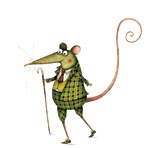Country mouse - Mark Hedges
Comparing foxes to African game, Mark finds that all have distinctive markings on their rear: why could this be?


Why is the tip of a fox's tail white? There are many theories, some folk stories and even the odd scientific paper on it, but nobody seems certain. What is sure is that evolution didn't put it there for fun. The white tip is there for a purpose, one that made it evolutionarily superior to foxes that didn't have the white tip.
I think I may have the answer, but I had to go to Africa to find out. Among Africa's wild game, almost all types of animal have distinctive tails or bottoms from the rest of their body: strange lavatory seat markings on a waterbuck's backside, black tips to lions' tails and the erect tails of warthogs when they run.
Our African guide was adamant that it was a 'follow me' device so that youngsters could track their parents through the bush. It makes sense; certainly, fox cubs follow their mothers. Stoats move around in family groups, too. But then, of course, they have a black tip to their tail, even when their coat is white in winter. Red deer and roe deer wear white tips, and fallow have a white bottom. What do you think? Is it all simply a 'follow me' device?
Sign up for the Country Life Newsletter
Exquisite houses, the beauty of Nature, and how to get the most from your life, straight to your inbox.
Country Life is unlike any other magazine: the only glossy weekly on the newsstand and the only magazine that has been guest-edited by HRH The King not once, but twice. It is a celebration of modern rural life and all its diverse joys and pleasures — that was first published in Queen Victoria's Diamond Jubilee year. Our eclectic mixture of witty and informative content — from the most up-to-date property news and commentary and a coveted glimpse inside some of the UK's best houses and gardens, to gardening, the arts and interior design, written by experts in their field — still cannot be found in print or online, anywhere else.
-
 George Monbiot: 'Farmers need stability and security... Instead, they're contending with chaos'
George Monbiot: 'Farmers need stability and security... Instead, they're contending with chaos'The writer, journalist and campaigner George Monbiot joins the Country Life podcast.
By Toby Keel
-
 Country Life 30 April 2025
Country Life 30 April 2025Country Life 30 April 2025 is a glorious celebration of the country house in Britain, and the tale of its renaissance in the last fifty years.
By Country Life